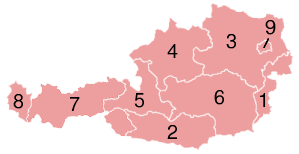States of Austria
|
|
Since Austria is a federal republic according to the constitutional framework of Austrian politics, Austria's nine provinces are customarily referred to as States of Austria or Bundesländer, singular Bundesland. Austrian federalism is largely notional, the federal states being granted comparatively little actual autonomy. On the one hand, federal legislature takes precedence over state legislature in almost all matters of practical importance, including but not limited to criminal law, corporate law, most other aspects of economic law, education, academia, welfare, telecommunications, and the health care system. On the other hand, Austria's federal states have no stand-alone judiciary, the federal constitution defining jurisdiction to be exclusively federal matter. Austrian provinces thus are neither formally nor practically endowed with statehood in the sense in which American or even German states are. Even so, Austrians tend to passionately identify with their respective states and determinedly defend what little independent governance their provinces have. It is not unheard of for Austrians to consider themselves, for instance, Tyrolean first, Austrian second. The nine states of Austria, listed alphabetically by official German name, are:
| English | German | ||
| 1. | Burgenland | Burgenland | |
| 2. | Carinthia | Kärnten | |
| 3. | Lower Austria | Niederösterreich | |
| 4. | Upper Austria | Oberösterreich | |
| 5. | Salzburg | Salzburg | |
| 6. | Styria | Steiermark | |
| 7. | Tyrol | Tirol | |
| 8. | Vorarlberg | Vorarlberg | |
| 9. | Vienna | Wien |
The provinces of Upper Austria, Lower Austria, Vienna, and Burgenland are situated in the Danube valley and thus consist near-totally of terrain accessible and easily arable. The other five provinces, in contrast, are part of the eastern foothills of the Alps and thus comparatively unsuitable for agriculture. Their terrain is also relatively inimical to heavy industry and long-distance trade. Accordingly, the population of what now is the Republic of Austria has been concentrated in the former four provinces since prehistoric times. Austria's most densely populated state is the city state of Vienna, kernel of what is Austria's only metropolitan area. Lower Austria only ranks fourth with regard to population density even though containing Vienna's suburbs; this is due to large areas of land predominantly agricultural. The alpine province of Tyrol, the less alpine but geographically secluded province of Carinthia, and the definitely not alpine but near-exclusively agricultural province of Burgenland are Austria's least densely populated states. The alpine province of Vorarlberg is an anomaly. The following ranked lists of Austrian states cites population figures from the 2001 census:
| State | Capital | Population | Area | Density | Cities | Towns | |
| 1. | Vienna | - | 1,550,123 | 415 | 3735.2 | 1 | 0 |
| 2. | Lower Austria | St. Pölten | 1,545,804 | 19,178 | 80.6 | 74 | 499 |
| 3. | Upper Austria | Linz | 1,376,797 | 11,982 | 114.9 | 29 | 416 |
| 4. | Styria | Graz | 1,183,303 | 16,392 | 72.2 | 34 | 509 |
| 5. | Tyrol | Innsbruck | 673,504 | 12,648 | 53.2 | 11 | 268 |
| 6. | Carinthia | Klagenfurt | 559,404 | 9,536 | 58.7 | 17 | 115 |
| 7. | Salzburg | Salzburg | 515,327 | 7,154 | 72.0 | 10 | 109 |
| 8. | Vorarlberg | Bregenz | 372,791 | 2,601 | 143.3 | 5 | 91 |
| 9. | Burgenland | Eisenstadt | 227,569 | 3,965 | 70.0 | 13 | 158 |
The population figures cited are generally assumed to be accurate to within five percent and to remain so until the next census, scheduled for 2011. Areas are given in square kilometers, population density is expressed in inhabitants per square kilometer. For the purpose of the above list, a "city" is a community defined to be a city by Austrian law; a "town" is a community not defined to be a city. Many of Austria's "cities" have population figures on the order of ten thousand inhabitants, some are even smaller.
In terms of boundaries, the State of Salzburg is equivalent to the former Austro-Hungarian Duchy of Salzburg, where Austria-Hungary was the wide-stretching multinational empire from whose ethnically Germanic kernel the Republic of Austria emerged when the empire was torn apart by nationalist and republicanist forces near the end of World War I. The provinces of Upper Austria and Lower Austria are mostly equivalent to what formerly were the two semi-autonomous halves of the Archduchy of Austria, a principality which formed the empire's historic heartland and which had to cede significant tracts of land to Czechoslovakia in the aftermath of the empire's dissolution. Similarly, the State of Carinthia descends from the Duchy of Carinthia, the State of Styria descends from the Duchy of Styria, and the State of Tyrol descends from the Duchy of Tyrol; these provinces had to cede territories to Italy and Yugoslavia when Austria emerged in its present form. Also, the state of Vorarlberg had been a part of the Duchy of Tyrol up until 1918. The city state of Vienna was a part of Lower Austria up until 1921. The State of Burgenland is a more or less artificially agglutinated entity consisting of four ethnically Germanic districts of Hungary that were ceded to Austria in 1920-1921.Template:States of Austria
bg:Административно деление на Австрия de:Bundesland (Österreich) fr:Länder autrichiens it:Länder (Austria) ms:Negeri di Austria nl:Deelstaat (Oostenrijk) ja:オーストリアの地方行政区画 no:Østerrikes delstater pl:Podział administracyjny Austrii pt:Estados da Áustria ro:Landurile Austriei sv:Österrikes förbundsländer

